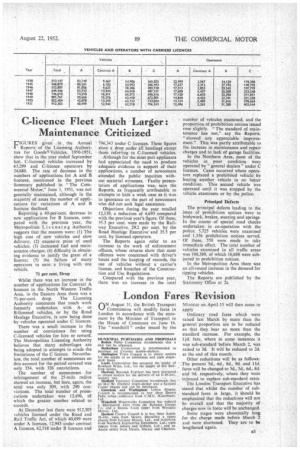C-licence Fleet Much Larger : Maintenance Criticized
Page 37

If you've noticed an error in this article please click here to report it so we can fix it.
FIC;URES given .in the Annual Reports of the Licensing Authorities for Goodst Vehicles, 1950-1951; show that in the year ended September last, C-Iicensed vehicles increased by 63,299 and C-licence operators by 24,880. The rate of decrease in the numbers of applications for A and la licences, mentioned in the previous Summary published in " The Commercial Motor," June 1, 1951, was not generally maintained, although in the majority of areas the number of applications for variations of A and B licences declined.
Reporting a 4Q-percent. decrease in new applications for B licences, compared with the previous year, the Metropolitan Lice ne in g Authority suggests that the reasons were: (1) The high cost of new vehicles and slow delivery; (2) excessive price of used vehicles; (3) increased fuel and maintenance charges; (4) difficulty in obtaining evidence to justify the grant of a licence; (5) the failure of many operators to earn a -living with one vehicle.
71 per cent. Drop Whilst there was an increase in the number of applications for Contract A licences in the North Western Traffic Area, in the Eastern Area there was a 71-per-cent. drop. The Licensing Authority comments that much work formerly undertaken with Aor B-licensed vehicles, or by the Road Haulage Executive, is now being done by vehicles operated under C licences.
There was a small increase in the number of convictions for using C-licensed vehicles for hire or reward. The Metropolitan Licensing Authority believes that many subterfuges are being adopted in attempts to evade the limitations of the C licence. Nevertheless, the total number of summonses on this account for the period covered was only 354, with 326 convictions.
The number of summonses for infringement of the 25-mile radius showed an increase, but here, again, the total was only 309, with 290 convictions. The total number of prosecutions undertaken was 12,496, de( which the greater number related to records.
At December last there were 912,303 vehicles licensed under the Road and Rail Traffic Act, of which 40,499 were under A licences, 12,943 under contract A licences, 62,518 under B licences and 796,343 under C licences. These figures show a drop under all heading § except those referring to C-licensed vehicles.
Although for the most part applicants had appreciated the need to produce adequate evidence in support of their applications, a number of newcomers attended the public inquiries without material witnesses. Faulty presentation of applications was, says the Reports, as frequently attributable to attempts to hide a weak case as it was to ignorance on the part of newcomers who did not seek regal assistance.
Objections during the year totalled 12,139, a reduction of 4,693 compared with the previous year's figure. Of these, 35.3 per cent, were made by the Railway Executive, 29.2 per cent, by the Road Haulage Executive and 35.5 per cent, by licensed operators.
The Reports again refer to an increase in the work of enforcement officers, whose returns show that most offences were concerned with driver's hours and the keeping of records, the use of vehicles without a carrier's licence, and breaches of the Construction and Use Regulations.
Compared with the previous year, there was an increase in the total number of vehicles examined, and the proportion of prohibition notices issued rose slightly. "The standard of maintenance has not," say the Reports, "showed any appreciable improvement" This was partly attributable to the increase inertaintenance and repair charges and to lack of garage facilities.
In the Northern Area, most of the vehicles in poor condition were operated by "general dealers" under C licences. Cases occurred where operators replaced a prohibited vehicle by buying another vehicle in no better condition. This second Vehicle was operated until it was stopped by the vehicle examiners or by the police.
Principal Defects The principal defects leading to the issue of prohibition notices were in bodywork, brakes, steering and springs. In the course of special road checks undertaken in co-operation with the police, 5,725 vehicles were examined and 1,356 prohibition notices served. Of these, .550 were made to take immediate effect. The total number of vehicles examined in all traffic areas was 108,389, of which 16,688 were subjected to prohibition notices.
In the Metropolitan Area there was an all-round increase in the demand for tipping vehicles.
The Reports are published by the Stationery Office at 2s.




















































































